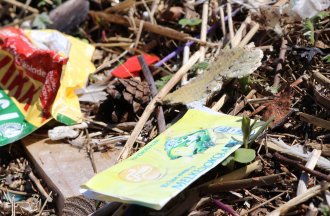
Plastic pollution
Our researchers work with a transdisciplinary approach, combining social and natural sciences and stakeholder involvement to develop solutions. We collaborate both nationally and internationally.
Plastics are ubiquitous, found in the most remote areas from the deepest ocean depths to the highest mountains. Over 400 million tons of plastic are being produced annually, and without effective mitigations measures, this amount is projected to nearly triple by 2060.
Mismanaged plastic often ends up in nature. Plastics are produced with thousands of additives, hundreds of which are known to be toxic or hazardous to human or animal health. Plastic pollution is one of the fastest growing environmental issues, leading to adverse effects on ecosystems, social and economic systems, and human health.
Plastic items that end up in nature break down into smaller fractions, all the way down to nano- and microplastics. These fractions can be ingested by organisms or cause entanglement. Additionally, stray plastics release chemical additives into the environment, which pose significant risks to living organisms and humans.
How NIVA contributes
NIVA takes a strong interdisciplinary and lifecycle approach to researching and addressing plastic pollution, with expertise on a variety of aspects including monitoring and analysis, mitigation, alternatives to plastic, clean-up measures, and policy.
At NIVA, we work on the ecotoxicology and risk assessment of plastics and associated chemicals at both national and international levels, through projects such as MicroLEACH, REVEAL, and MicroOPT, as well as researching car tyre and road wear particles as a source of plastic pollution and their environmental impacts.
We also work on harmonising methods for environmental monitoring for all plastic size fractions through projects like EUROqCHARM and PlasticTrace. NIVA leads Norway’s national monitoring programme on microplastics in the Norwegian environment (MIKRONOR), and our microplastic laboratory offers comprehensive analyses of environmental samples.
NIVA works closely with both national and international authorities and actively contributes with knowledge from several projects towards method harmonisation for local, regional and international monitoring, through OSPAR, ICES, the EU Marine Strategy Framework Directive, the Arctic Monitoring Assessment Programme, and in collaboration with the Japanese Ministry of the Environment.
Furthermore, NIVA researchers contribute with our best practise recommendations towards ISO working groups in the development of standards for microplastic analysis across environmental matrices.
To improve waste management, implement policies and regulations and innovate in the production and design of plastic materials and products, it is crucial to understand their sources and fate through environments. This is especially important in countries where plastic waste management systems are often inadequate. NIVA has contributed to capacity and competence building in many Asian countries through several projects (e.g. ASEANO 2, INOPOL, SINOPLAST 2). We focus on topics like understanding the sources and transport channels of plastic pollution, Just Transitions and supporting governmental policy makers and industry decision makers.
NIVA also participates in international efforts such as the United Nations Environment Programme’s plastic treaty negotiations, aiming for a legally binding agreement by 2024 to end plastic pollution. Through IKHAPP, NIVA also hosts the secretariat for the Scientists’ Coalition for an Effective Plastics Treaty during the negotiation process.
Read more about IKHAPP, the Internation Knowledge Hub Against Plastic Pollution, where NIVA and our partners collect, critically analyse, and disseminate scientific knowledge to support effective policies and actions to fight plastic pollution globally.
ASEANO 2 is a capacity building project in the ASEAN region aiming to build and enhance capacity and knowledge to measure, evaluate and address plastic pollution.
EUROqCHARM was an EU Horizon 2020 project that sought to establish harmonised methods for monitoring when assessing macro, micro-and nanoplastics in the environment, as well as outline standards and recommendations for policy and legislation. This work led to the establishment of Technological Readiness Levels to support methodology decision making and the development of reference materials for proficiency testing in microplastic analysis.
INOPOL is an India-Norway cooperation project on capacity building for reducing plastic and chemical pollution in India.
MicroLEACH investigates the long-term effects of microplastics and their additives on a selection of marine organisms found in the Norwegian environment.
MIKRONOR is Norway’s monitoring programme of microplastics in coastal areas, rivers and lakes. This programme includes the assessment of marine, freshwater and terrestrial samples for the presence of microplastics and has been running since 2021.
PAPILLIONS’ overall aim is to shed light on the sustainability of plastic use in European agriculture in terms of emissions of micro-and nanoplastics, leakage of their chemical additives, and the impact of this on the soil.
PlasticTrace aims to address the urgent need for development and harmonisation of methods for identification, characterisation and quantification of small micro/nanoplastics in drinking water, food and environmental matrices.
PlasticTreaty help to ensure that the new international treaty to combat plastic pollution is effective and that it takes into account the needs and circumstances of developing countries and economies in transition, as well as supporting the independent Scientists’ Coalition.
PROLAND addresses the sources of plastic pollution in agricultural soils.
SINOPLAST 2 contributes to reduce plastic waste and marine litter originating from China, supporting the implementation of the new global plastics treaty.



.jpeg)